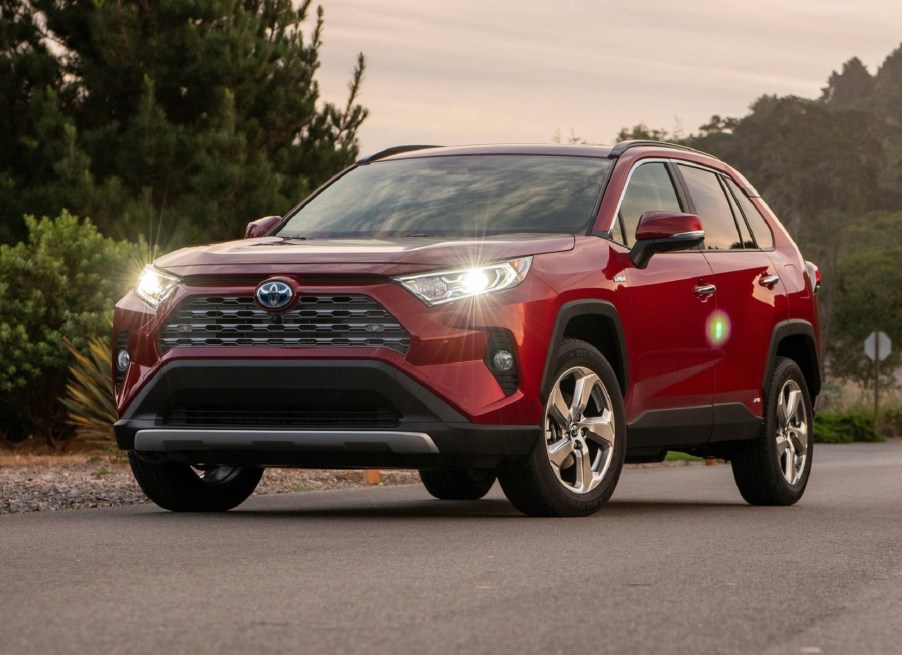
Are 2019 and 2020 Toyota RAV4 Hybrids Suffering Battery Issues?
Among hybrid crossovers/SUVs, Toyota’s RAV4 Hybrid has a lot to offer. It may even overshadow its non-hybrid version. However, the RAV4 Hybrid has also suffered from a few glitches, including fuel tank filling problems and failing suspension components. And recent owner and forum complaints seem to indicate that the hybrid crossover’s battery may have trouble staying charged.
Owners are complaining about 2019 and 2020 Toyota RAV4 Hybrid battery drain
Unlike the plug-in hybrid RAV4 Prime, the Toyota RAV4 Hybrid doesn’t have a lithium-ion battery pack, Car and Driver explains. Instead, it has a 1.6-kWh nickel-metal-hydride battery connected to 3 electric motors and a 2.5-liter four-cylinder engine, Car and Driver reports. And that engine requires a conventional 12V lead-acid battery to start it and run the conventional electronics, ToyotaUK explains.
And, like any normal car or motorcycle battery, it can go flat. That’s the issue 2019 and 2020 Toyota RAV4 Hybrid owners on RAV4World, CarGurus, and Kelley Blue Book forums are complaining about. They park their hybrid crossovers for a few days and come back to find they can’t start it because the battery’s dead. After a jump-start, the engine fires right up. But then the cycle repeats.

To be fair, any car’s battery, hybrid or not, can die if it isn’t driven regularly. Or, if it’s stored improperly. For example, if you leave your headlights on overnight. In fact, Toyota’s customer service site recommends hybrid owners turn their vehicles on “at least every 2 weeks” to prevent battery drainage. However, the forum reports claim the Toyota RAV4 Hybrids were sitting idle for only a few days. And no one left their lights on.
Are non-hybrid Toyota RAV4s and/or its competitors suffering similar issues?
Although many of these reports specifically reference the Toyota RAV4 Hybrid, non-hybrid models have also been affected, sub-Reddit r/RAV4club users report. The owner left their RAV4 parked, fully-off, for a few days, and came to find their battery dead.

Based on these reports, it appears the issues are limited to 2019 and 2020 Toyota RAV4 and RAV4 Hybrids. The 2019 model year has been noted for multiple issues, including electrical ones. And in addition to the previously-mentioned recalls, there’s also been a recall on the 2019 and 2020 Toyota RAV4’s engine.

That being said, the Toyota RAV4 and RAV4 Hybrid aren’t the first crossovers to suffer mysterious battery drain issues. The Honda CR-V, which is now available in hybrid form, has also had these problems, CarGurus forum users report. The 2012 model is particularly notorious for battery problems, though even newer CR-Vs have been noted for electrical glitches.
Luckily, the Honda CR-V’s battery issues may point the way to the Toyota RAV4 Hybrid’s battery problems.
Is there a solution available?
According to several CarGurus and CRVOwners forum users, and HondaProblems.com, the CR-V’s battery drain problems stem from software issues. The reason why even well-kept batteries drain over time is due to ‘parasitic drain.’ In other words, something in the car keeps drawing power from the battery until it dies.
In the case of the Honda CR-V, the crossover’s vehicle stability assist wouldn’t shut off properly. The VSA would stay awake and kill the battery. Honda issued numerous TSBs, CarComplaints reports, and resolved the problem with a software update. The automaker had to issue additional software updates for the powertrain control module and electronic parking brake because they too would stay awake, CarComplaints reports.
As of this writing, Toyota hasn’t issued a TSB or a recall regarding the RAV4 or RAV4 Hybrid’s batteries. And based on Consumer Reports’ published owner complaints, it appears this problem may not affect every single RAV4. But based on CR-V forum users’ claims, the battery issue took quite a while to resolve. That’s unfortunately the nature of software bugs.
Until there’s a fix, the best way to make sure your Toyota RAV4 or RAV4 Hybrid’s battery doesn’t die is to turn it on regularly. Or, if that’s not possible, consider investing in a battery tender.
Follow more updates from MotorBiscuit on our Facebook page.


